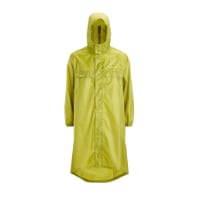I guess it depends on the concentration, as both permethrin and pyrethrin are used for head lice treatment.
The product and application is different. Permethrin cream is only 5% with additives (1-part Permethrin to 3-parts additives), and studies suggest that only 2% is actually effectively applied to the scalp, absorbed, then rinsed away. In clinical trials, approximately 75% of patients treated with Permethrin cream, 5%, continued to manifest pruritus (severe itching of the skin) at 2 weeks and had cessation by 4 weeks.
Clothing Dips with Permethrin, which is what I’ve been discussing, are around the 36.8 percentile mark, or greater. Big difference in concentration levels, and no additives to reduce associated skin contact and adverse reactions as in the cream.
If you have head lice, then I would probably use this product; that doesn’t mean its safe – just effective.
To use an extreme example; chemotherapy is used to treat cancer – is it safe – not at all – just relatively effective.
Everyone makes their own decision, for the products they wish to use. The concern is, not everyone applies a product in a safe manner, or for the right reasons.
So with that, my end of this discussion is closed.
Cheers,
Addition:
I’ve just reviewed a document from the EPA site, which may be of further interest.
United States Prevention, Pesticides EPA 738-F-09-001 Environmental Protection and Toxic Substances August 2009 Agency - Permethrin Facts:
“EPA estimates that the permethrin exposure a patient is expected to receive from a typical single application of a 1% and 5% permethrin pharmaceutical cream, respectively, is 450 to 2300 times greater than the combined exposure from the dietary and other non-occupational sources of permethrin.”
Yet it's still considered at an acceptable safe level. Hmmm...
Some additional information:
EPA Sites states “Permethrin repellent products used for factory-treatment of clothing or as spray-ons for clothing are not to be applied to certain clothing such as underwear. For this reason, the label instructs consumers to wash permethrin-treated clothing separately from non-treated clothing”
EPA, also states the use and safety of Permethrin is currently under review and a report scheduled for release in 2017. The EPA has also stated the following – “Permethrin is Likely to Cause Cancer according to the EPA”
EU: Permethrin (CAS No. 52645-53-1) is not authorised for use in plant protection products in the EU where its agricultural use has been banned under Directive 91/414/EEC since 2003.
In Ontario (Canada): The ban on certain pesticides “Permethrin”. The provincial Ministry of Environment studied pesticide concentrations in ten urban streams before and after their ban came into effect (2008 vs. 2009) and compared the findings. The study’s author states:.. In fact, in some streams pesticide concentrations were up to 97% lower.”
Article on Pyrethroids (2009): Not as safe as you think
Permethrin is a synthetic pyrethrin (C21H20Cl2O3). In other words, it is a man-made poison that is a copy of two poisons found in plants.
While pyrethroids may be amongst the least toxic of insecticides, they are an excitatory nerve poison, acting upon the sodium ion channels in nerve cell membranes: by sending a train of impulses rather than a single one, they overload the pathways, blocking the passage of sodium ions across cell membranes; similar in action to organophosphates (which include the now banned DDT); inhibits ATPase, which affects the release of acetylcholine, monoamine oxidase-A and acetylcholine; inhibits GABAa receptors, resulting in convulsions and excitability (and more 'minor' problems such as sleep disorders);
known to be carcinogenic;
liver damage
thyroid function
cause chromosomal abnormalities in mice and hamsters;
are highly toxic to insects, fish, and birds;
mimic estrogen, leading to estrogen dominant health problems in females and feminizing effects in males, including lowered sperm counts and abnormal breast development;
sub lethal doses have produced a wide array of abnormal behaviors, including aggression, and disruption in learning and learned behaviors




















